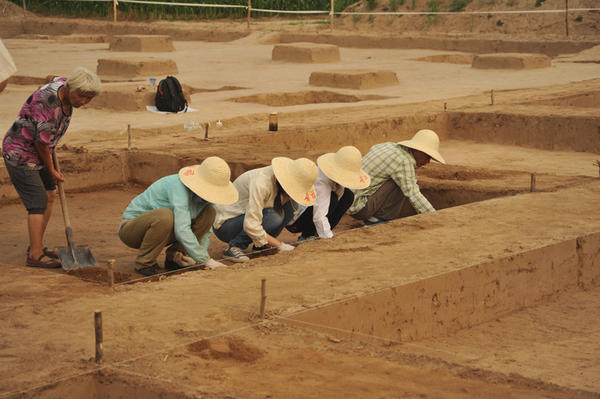The Xia Dynasty Travel Episode II The Dongzhao Site in Zhengzhou: 'Bridgehead' of the Xia Dynasty
The Xia Dynasty Travel Episode II
The Dongzhao Site in Zhengzhou: 'Bridgehead' of the Xia Dynasty
追寻夏的轨迹②丨东赵遗址:夏都东方桥头堡
Famous for the remains of three ancient cities in different periods which are stacked on top of one another, the Dongzhao Site in Zhengzhou city of Henan province was included on the list of China's top 10 archaeological finds of 2014.
郑州东赵遗址因为发现了大、中、小三座“叠套”在一起的夏商周时期古城而遐迩闻名,入选2014年度中国十大考古新发现之一。
Click on the video
The sites and ruins of the Xia (2070 BC-1600 BC) and the Shang (1600 BC-1046 BC) dynasties are densely distributed in northwestern suburban Zhengzhou, one of the key areas for many important academic issues related to China's Bronze Age. To explore the formation and development of the early states in the Central Plains, a team led by the Institute of Cultural Relics and Archaeology of Zhengzhou and the School of Archaeology and Museology of Peking University has conducted large-scale fieldwork at the Dongzhao site since 2012 with relics of the late Longshan Culture (around 2500 BC-2000 BC), the Xinzhai Phase (around 1870 BC-1720 BC), the Erlitou Culture (around 1735 BC-1530 BC), the Erligang Culture (around 1600 BC-1400 BC), the Western Zhou Dynasty (1046 BC-771 BC) and the Eastern Zhou Dynasty (770 BC-256 BC) discovered.
郑州市西北郊密布夏商时期遗址,是解决中国青铜时代诸多重大学术问题的关键区域之一。为探讨“中原腹心地区早期国家的形成与发展”,郑州市文物考古研究院与北京大学考古文博学院联合组成考古队,从2012年开始,持续对东赵遗址进行了大规模的田野工作,发现了龙山文化晚期、新砦期、二里头时期、早商二里岗期、两周时期文化遗存。
Because of its long-lasting and complete archaeological cultures, the site is rare of its kind in the Central Plains. At the remains of three ancient cities in different periods which are stacked on top of one another, many important cultural relics were unearthed. The relics unearthed from the small and the medium cities are related to the Xia Dynasty, while those discovered from the large city belong to the Eastern Zhou Dynasty.
该遗址考古学文化延续时间之长、文化序列之连续完整,在中原地区同类遗址中甚为罕见。大、中、小三座“叠套”在一起的古城里,均有十分重要的文化遗迹出土,其中的小城、中城和夏文化有关,大城则是东周时期的。

Archaeologists work at the Dongzhao Site. [Photo provided to Henan Daily]
Located in the northeast of the site, the small city is basically square in shape with an area of 22,000 square meters. First built in the early Xinzhai Phase (the early Xia Dynasty), the city was completely abandoned in the first stage of the Erlitou Culture (the middle Xia Dynasty). Currently, only one city ruin of the Xinzhai Phase was discovered at the Xinzhai Site in Xinmi of Zhengzhou, so it still remains controversial. The city ruin discovered at the Dongzhao Site is the second of its kind, and the first in the north of the Songshan Mountain.
小城位于遗址东北部,平面基本呈方形,面积2.2万平方米。城址始建年代为新砦期早段(夏代早期),二里头一期(夏代中期)时完全废弃。目前所知的新砦期城址,仅在郑州新密新砦遗址发现1座,学界尚有异议。东赵遗址的这座城址是目前发现的第2座新砦期城址,也是嵩山以北区域第1座新砦期城址。
Outside the southern city wall discovered more than 40 regular distributed ash pits. All of them are round in top and similar in size with 5 or 6 in a group, whose filling is mostly red clay with dense texture. Pig skeletons, tortoise shells and human bones were found in some pits. Some experts believe that such pits were used for storage, while others think they were related to sacrifices. It was the first time that those special remains of the Xinzhai Phase (the early Xia Dynasty) were found with great academic values.
在小城南墙外,集中发现了40余座袋形灰坑,这些灰坑互不相扰,灰坑口部均为圆形,大小相若,五、六座为一组,分布规律,残存坑口部填土多为质地紧密的红粘土。在部分坑内发现有猪骨架、龟壳、人骨等。关于此类遗存的性质,有专家认为是仓储类遗存,有人认为与祭祀有关。这类特殊遗存是新砦期遗存(夏代早期)中的首次发现,具有重大学术研究价值。

A pottery ware unearthed at the Dongzhao Site. [Photo provided to Henan Daily]
Located in the middle of the site, the medium city is basically trapezoidal in shape with an area of 90,000 square meters. First built in the second stage of the Erlitou Culture, the city was completely abandoned in the fourth stage of the Erlitou Culture (the late Xia Dynasty). Since there are not many city ruins of the Erlitou Culture at present, the city ruins at the Dongzhao Site are indispensable for the study of the regional settlement form and geopolitical structure.
中城城址位于东赵遗址中部,平面基本成梯形,面积9万平方米。城址始建于二里头二期,废弃于二里头四期(夏代晚期)。目前所见二里头文化城址不多,东赵二里头文化城址,对于夏的区域聚落形态及政治地理结构研究,是不可回避的重点对象。
Two special phenomena were also mentioned by Zhang Jiaqiang who led the excavation.
在采访中,张家强特别提到了两种特殊遗迹现象。
First, a bone pit of the second stage of the Erlitou Culture was discovered. The bones in the pit are shoulder blades with orderly burn marks, belonging to almost 20 head of cattle. Each bone is about 30 centimeters long. Among all the bone pits of the Erlitou Culture, such a pit has the largest number of bones, which is of great significance for the study of the divination system in the Xia Dynasty, even the whole pre-Qin period (before 221 BC). Second, a child's bones were also found within the wall of the medium city, believed to be related to the ancient sacrifice rites, which is not seen in other sites of the Erlitou Culture.
一是发现了一座二里头文化二期的卜骨坑,卜骨均系牛肩胛骨,未去臼角与岗脊,只灼未钻,灼痕排列整齐。卜骨个体较大,多长约30多厘米,应为完整放置,分属近20个个体。这是目前发现的二里头时期出土卜骨最多的卜骨坑,对夏代乃至先秦时期占卜制度具有重要意义。二是在二里头时期城墙基槽内发现儿童骨架,应与祭祀活动相关,这一现象系同时期其他遗址所未见。

H367 (the Xinzhai Phase). [Photo provided to Henan Daily]
As for the importance of the Dongzhao Site in the study of the culture of the Xia Dynasty and the site's relationship with the Erlitou Site (capital site of the middle and late Xia Dynasty), Zhang said that the Dongzhao Site must have been a very important place in the Xia Dynasty because the remains of the early and late Xia Dynasty were found here with city ruins discovered. At the Erlitou Site, the capital site of the middle and late Xia Dynasty, palace ruins, bronze wares, jades, etc., were discovered, while at the Dongzhao Site, city ruins were unearthed, but there were not many bronze wares and jades, which indicates that it might be an important military base.
谈到东赵遗址在夏文化研究中的地位、与夏代中晚期都城偃师二里头的关系,张家强说,东赵遗址的夏代遗存从早期到晚期一直存在,而且都发现了城址,说明此地在夏代非常重要。二里头遗址是夏代中晚期具有都邑性质的遗址,有宫殿、青铜礼器、玉器等等,东赵遗址虽然有城,但是青铜礼器、玉器比较少,等级不是太高,可能是重要的军事据点。(中文来源/河南日报客户端 记者/张体义 胡春娜 翻译/赵汉青 视频/实习生王君艺 审校/陈行洁 白玉杰)
Related reports
The Xia Dynasty Travel Episode V The Puchengdian Site: Two Ancient City Ruins Discovered
The Xia Dynasty Travel Episode VI The Xinzhai Site in Xinmi: The First Capital of the Xia Dynasty?
The Xia Dynasty Travel Episode VII The Yuzhuang Site: Unveiling the Noble Life 4,000 Years Ago
追寻夏的轨迹⑦丨叶县余庄遗址:探寻4000年前的“贵族气息”
The Xia Dynasty Travel Episode IX The Erlitou Site in Yanshi: A 'Dynasty' in a Small Village
